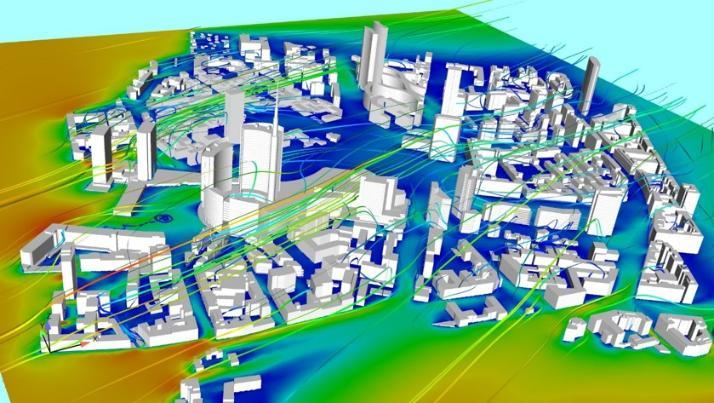Research impact
Economic impact
Dr Keenahan has been an invited speaker by Engineers Ireland and engineering and architecture firms in New York, Boston and Ireland. The number of Engineering Consultancy firms offering CFD modelling for the built environment as a service is ever increasing. An early adopter of this methodology, with whom Dr Keenahan works closely, now employs over 50 people on their CFD team with an annual turnover of €5 million, and have invested in dedicated servers to run CFD simulations. This represents a priority shift in expenditure. Every engineering firm that provides consultancy services in wind has the potential to benefit from a shift towards CFD.
Planning authorities are now accepting planning applications that include wind analysis using CFD modelling, some of which can be traced back to CFD work carried out by Dr Keenahan. Therefore, clients of the abovementioned firms will benefit from the reduced time and cost associated with CFD modelling as compared to wind tunnel testing.
Policy impact
Existing codes of practice for engineering – known as Eurocodes – give guidance on designing buildings to resist the forces of wind. But winds can have a significant impact on the comfort and safety of people and cyclists, and this is not yet considered in the codes of practice. Nor do the codes recognise CFD modelling. In the Irish context, only An Garda Síochána have the authority to close an area in what they perceive to be unsafe winds, without robust guidance on when to do so.
In conjunction with the National Standards Authority of Ireland, Dr Keenahan is preparing a policy on the holistic treatment of wind in the built environment. This will support decision-makers on the safe operation of infrastructure in high winds, and will include:
- Guidance on designing the built environment for safe and pleasant public use (e.g. occupant comfort on balconies)
- A protocol for preventing access to areas of the built environment due to dangerous wind conditions (e.g. closing a bridge)
- Guidance on using CFD modelling for wind analysis.
At the same time, Dr Keenahan sits on a working group revising the “Irish National Annex of the Wind Eurocode”. All engineers across Europe must follow the Eurocodes, and each country can develop its own national annex for some country-specific issues. Dr Keenahan’s research will therefore directly impact the next version of this code of practice for wind engineering, which is due to be published in 2022, with widespread adoption in 2025. The code is expected to include the use of CFD for preliminary wind analysis.
Social and environmental impacts
Ultimately, Dr Keenahan’s research will inform future design methods that will provide safer and more pleasant public spaces, better quality infrastructure, and safer transport in exposed wind environments. The research will benefit the whole of society by enhancing the user experience of the built environment. What’s more, faster wind speeds are highly likely to occur as a result of climate change, so this research is expected to become increasingly important and impactful in future years.
Academic, technological and educational impact
Using CFD to model the built environment represents the formation of a new discipline and is a step beyond the state-of-the-art. A special issue on this topic was proposed by Dr Keenahan in 2020 in the journal of Applied Sciences, where she is a guest editor. Dr Keenahan is building capacity through supervising four PhD students in the last three years. In this time, she has closely collaborated with Arup, through co-authoring publications, co-supervising six Masters of Engineering Research Projects, and the subsequent employment of one of these students in a specialist, highly skilled role on the CFD team at Arup.
 “Wind actions on critical infrastructure, such as long span cable stayed bridges, and the response of such structures from both a structural and operational perspective are often the source of great debate and uncertainty during the detailed design and construction of large scale civil engineering projects. Wind loading parameters are often not adequately captured within design codes and numerous studies and wind tunnel tests are required in an attempt to establish realistic wind forces and their associated aerodynamic effects for a particular location and structure. Computational Fluid Dynamics presents a real opportunity to complement and enhance current practice and will aid our understanding of how structures behave under a myriad of wind loading conditions in a fast and cost-effective manner.”
“Wind actions on critical infrastructure, such as long span cable stayed bridges, and the response of such structures from both a structural and operational perspective are often the source of great debate and uncertainty during the detailed design and construction of large scale civil engineering projects. Wind loading parameters are often not adequately captured within design codes and numerous studies and wind tunnel tests are required in an attempt to establish realistic wind forces and their associated aerodynamic effects for a particular location and structure. Computational Fluid Dynamics presents a real opportunity to complement and enhance current practice and will aid our understanding of how structures behave under a myriad of wind loading conditions in a fast and cost-effective manner.”
— Fergal Cahill, Senior Engineer – Structures Engineering & Asset Management, Transport Infrastructure Ireland